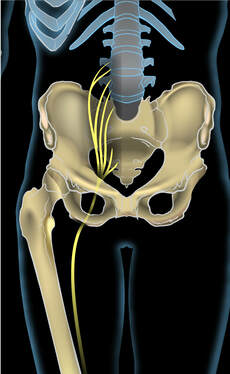 Leg and yes, the gluteal region too. Sciatica is one of those terms thrown around with varying degrees of accuracy, so I thought it might be time to talk about what it is..and isn't...and of course what osteopathy may be able to do to help. The idea behind sciatica is irritation of the sciatic nerve causing pain in the leg. Let's get the annoying 'know it all' stuff out of the way first... 1. There is no sciatic nerve...Really! What we call the sciatic nerve is actually a sheath containing 2 completely separate nerves, the tibial and fibular (or peroneal) nerves. 2. A slipped disc, disc protrusion, herniation etc cannot press on the sciatic (or fibular or tibial) nerve, these nerves are what are called peripheral nerves and are formed outside the spinal column (hence in the peripheral, not central, nervous system). What can get irritated in the spinal column, by a slipped disc etc, is a nerve root. These exit in pairs at each spinal level and then send branches which join in plexuses (plexi?) to form peripheral nerves Phew! OK, so lets assume we are talking about nerve pain, numbness or weakness in the buttock, maybe down the outside or back of the thigh and sometimes into the calf and foot. Where are the main places that the nerve can be irritated? The first place is in the spinal column. A disc bulge can press on the nerve root and cause pain down the leg. Typically L45 or LS discs are particularly prone to herniation and can bulge and press on l5 or S1 nerve roots which cause symptoms in these areas Overtight buttock muscles, especially piriformis can compress the sciatic bundle and irritate the nerves contained within. Typically this is felt as pain along the route of the nerve in the thigh and often doesn't extend beyond the knee although it can go all the way to the foot. The common fibular nerve is prone to injury and entrapment where it winds around the fibular head (the bony lump on the outside just below the knee). Relatively minor knocks here can stop the nerve gliding smoothly meaning that it can get stretched and harder bumps (hit by a car bumper etc) may lead to loss of power from the muscles it supplies, and foot drop. The tibial nerve can get trapped behind the knee, under soleus muscle and in the foot, in a structure called the tarsal tunnel, which can become congested due to poor foot mechanics. How do we know where the problem is? Sometimes it is very obvious from the history, where the injury took place and what kind or injury it was, sometimes examination and basic orthopaedic testing will find an obvious derangement and treatment of that will reduce or eliminate the symptoms. An MRI would be required to confirm a disc bulge and/or nerve conduction testing can show whereabouts a nerve is damaged. Beware though 80% of 40 year olds with no back problems or sciatica will have disc bulges on an MRI. So you may have a disc bulge and sciatica but it may not be the cause, or may be part of the cause and resolving an issue elsewhere may be enough to eliminate the symptoms What can an osteopath do? It depends...as always. If you have herniated a disc, nature may have to take its course, most disc herniations become asymptomatic within 12 weeks (sadly, not all). That said, sometimes even sciatica due to an apparent disc bulge may respond to treatment, either the treatment reduces local muscle spasming, postural issues or fluid congestion around the nerve root thus decreasing compression and irritation, or working elsewhere along the root of the nerve increases it's capacity sufficiently to reduce symptoms. If the problem is due to tight muscles in the buttock we can work to loosen those and, more importantly work out why they have overtightened and work on those factors also. Problems in the foot and further down the leg are often very amenable to osteopathic treatment. Finally, if you are suffering from sciatica it is probably affecting how you sit, walk etc and that will have a knock on effect on other tissues in your back and possibly in your other leg. We can work to minimise those disruptions, so that when your sciatica does go, you aren't left with a whole pile of other problems Picture
2 Comments
23/8/2022 12:57:50
I was impressed in this content! Thanks for sharing your story.
Reply
Your comment will be posted after it is approved.
Leave a Reply. |
Archives
February 2024
AuthorDamian is the principal osteopath at Vauxhall Village Osteopathy and Oval Osteopathy Categories
All
|


 RSS Feed
RSS Feed


